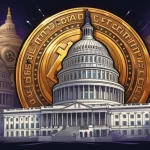CFTC Endorses Stablecoins, SEC Targets L2s, and Trump-Linked Crypto Sparks Controversy

Crypto Regulation at a Turning Point: CFTC Backs Stablecoins, SEC Eyes L2s, and Politics Muddies the Waters
Significant shifts are underway in the U.S. cryptocurrency arena as regulators and political forces collide with innovation. The Commodity Futures Trading Commission (CFTC) is paving the way for stablecoins to become collateral in derivatives markets, while the Securities and Exchange Commission (SEC) dangles an innovation carrot alongside a regulatory stick aimed at Ethereum Layer-2 networks. Add to that the murky ties of World Liberty Financial to the Trump family and the growing clout of crypto political action committees (PACs), and you’ve got a landscape brimming with promise and peril.
- CFTC’s Stablecoin Breakthrough: Proposal to allow stablecoins as derivatives collateral, bridging crypto and traditional finance.
- SEC’s Mixed Signals: Innovation exemptions for crypto projects clash with warnings on Ethereum L2 networks as potential exchanges.
- Political Quicksand: Trump-linked World Liberty Financial and crypto PACs raise ethical and national security alarms.
CFTC’s Stablecoin Leap: A New Era for Derivatives?
On September 23, the CFTC, led by acting-chair Caroline Pham, unveiled a bold initiative to permit tokenized stablecoins to serve as collateral in derivatives markets—think futures and options contracts based on future asset prices—alongside cash and U.S. Treasury bills. This isn’t a minor tweak; it’s a seismic nod to integrating digital assets into the financial mainstream. Stablecoins, for the uninitiated, are cryptocurrencies pegged to stable assets like the U.S. dollar (e.g., USDC or USDT), designed to minimize volatility. Allowing them as collateral means a trader could use, say, USDC to back a contract, potentially slashing costs and enabling 24/7 liquidity in a market traditionally bound by banking hours.
“Tokenized markets are here, and they are the future… collateral management is the ‘killer app’ for stablecoins in markets.” – Caroline Pham, CFTC Acting-Chair
Industry giants are on board. Circle, issuer of USDC, sees this as a transformative step. Their President, Heath Tarbert, didn’t mince words on the benefits.
“Using trusted stablecoins like USDC as collateral will lower costs, reduce risk, and unlock liquidity across global markets 24/7/365.” – Heath Tarbert, Circle President
Tether (USDT) and Ripple Labs (RLUSD) have echoed similar enthusiasm. With public comments on the proposal due by October 20, the stakes are high. If executed well, this could legitimize stablecoins as a backbone of modern finance, aligning with the ethos of effective accelerationism by speeding up tech adoption. But let’s not get starry-eyed. What happens if a stablecoin depegs during a market crash, as we saw with Terra/Luna in 2022, wiping out $40 billion in value overnight? A derivatives market reliant on shaky collateral could amplify systemic risks, turning a win into a disaster. Historically, the CFTC has been cautious with crypto, often playing second fiddle to the SEC, so this move signals a rare proactive stance—but it must come with ironclad oversight. Are we witnessing stablecoins becoming the new gold standard, or a ticking time bomb? For more on the regulatory perspective, check out the latest insights on CFTC’s stance on stablecoins and SEC’s focus on L2 networks.
Compounding the uncertainty is the CFTC’s own leadership crisis. The chair position has sat vacant for eight months, with Trump’s initial nominee, Brian Quintenz, derailed by opposition from the Winklevoss brothers of Gemini exchange fame. New contenders like Josh Sterling, Michael Selig, Tyler Williams, and even SEC Chair Paul Atkins are in the mix. This isn’t just a bureaucratic hiccup; it’s a glaring bottleneck at a time when decisive guidance is critical. Political games are stalling progress, and in a sector moving at lightning speed, delays could cost the U.S. its edge.
SEC’s Ethereum L2 Dilemma: Innovation or Overreach?
While the CFTC pushes forward, the SEC is sending conflicting vibes. On one front, they’re crafting an “innovation exemption” slated for release by year’s end, which would let crypto projects—think initial coin offerings (ICOs) or token airdrops—launch without the usual regulatory gauntlet. This syncs with the White House’s recent crypto-friendly policy nudge, a welcome shift after years of ambiguity that saw the SEC slap lawsuits on projects left and right. Hold the celebration, though—there’s a catch, and it’s a big one. SEC Commissioner Hester Peirce has flagged Ethereum Layer-2 (L2) networks, particularly those with centralized sequencers, as potential targets for regulation as exchanges.
“If you have a matching engine essentially that’s controlled by one entity that controls all the pieces of that, then that looks a lot more like an exchange and… we’re going to have to think about that.” – Hester Peirce, SEC Commissioner
Let’s break this down. L2 networks, like Coinbase-operated Base, are scalability solutions built on Ethereum to handle transactions faster and cheaper than the main blockchain, while still tapping its security. Think of them as express lanes on a congested highway. Sequencers are the traffic cops ordering these transactions; if one entity controls the sequencer, the system isn’t as decentralized as blockchain purists would like. Peirce’s argument is that this centralization mimics a traditional exchange—a marketplace matching buyers and sellers—thus warranting SEC oversight. To illustrate, Base processes thousands of transactions daily with a single sequencer under Coinbase’s control, per public blockchain data, raising eyebrows about power concentration.
The crypto community isn’t having it. Coinbase’s Chief Legal Officer, Paul Grewal, called out the SEC for peddling fear, uncertainty, and doubt (FUD).
“Framing sequencers on L2s like Base as exchanges misrepresents their function as a marketplace… Mislabeling them is actively spreading [fear, uncertainty and doubt].” – Paul Grewal, Coinbase Chief Legal Officer
Base’s lead developer Jesse Pollak and Ethereum creator Vitalik Buterin have pushed back too, arguing that L2s are technical layers, not marketplaces, and treating them as exchanges ignores their role in scaling decentralized systems. Here’s the rub: the SEC might have a point if centralized sequencers enable manipulation or fail to protect users—imagine a single point of failure freezing millions in transactions. But clamping down risks strangling one of blockchain’s most promising innovations. Ethereum’s L2 ecosystem, handling over $7 billion in total value locked as of late 2023, is a lifeline for scalability. Overregulation could push developers overseas to friendlier jurisdictions like the EU, where the Markets in Crypto-Assets (MiCA) framework offers clearer rules. Historically, the SEC’s tough stance on Ethereum—remember the 2018 “not a security” debate?—has fueled tension, and this feels like déjà vu. Balancing investor safety with innovation is a tightrope, and the SEC’s wobbly steps are shaking confidence.
Crypto’s Political Minefield: Ethics and Influence Under Fire
Beyond regulatory push-and-pull, politics is turning crypto into a battleground. World Liberty Financial (WLF), a DeFi platform tied to the Trump family, grabbed headlines at Korea Blockchain Week 2025 with plans for a debit card and app linked to Apple Pay, powered by its USD1 stablecoin. They’ve explicitly nixed launching their own blockchain, focusing on user access instead. Sounds slick, but a New York Times report dropped a bombshell, tying WLF co-founders Steve Witkoff (a Trump ally) and David Sacks (Silicon Valley VC and White House AI & Crypto Czar) to deals with the United Arab Emirates involving U.S. tech with national security implications. Democratic Senators Elizabeth Warren and Elissa Slotkin aren’t mincing words.
“It appears that in exchange for personal benefit, [Sacks and Witkoff] may have aided a foreign power’s effort to acquire U.S. technology that could present serious economic and national security risks.” – Senators Elizabeth Warren and Elissa Slotkin
This isn’t idle chatter. Crypto’s borderless nature makes it ripe for geopolitical entanglements, and if WLF’s leadership is prioritizing personal gain over national interest, it’s a blatant red flag for an industry already bleeding trust. Picture a small retail investor, hyped on DeFi’s promise of financial freedom, only to learn their platform’s backers might be playing fast and loose with ethics. Ties to the Trump name only amplify the scrutiny, turning WLF into a lightning rod whether the allegations hold or not. Crypto should empower individuals, not serve as a front for shady backroom deals.
Then there’s the muscle of pro-crypto PACs. Groups like Fairshake (backed by Coinbase, Ripple, and Andreessen Horowitz), Digital Freedom Fund (DFF, funded by the Winklevoss brothers), The Fellowship PAC, and America First Digital (AFD) are stockpiling cash to sway policymakers. Kraken dropped $1 million each to DFF and AFD, while Fairshake alone has raised over $100 million targeting the 2026 midterms. They’ve backed lawmakers like Senator Cynthia Lummis, a vocal crypto advocate, aiming to push bills for regulatory clarity. The intent might be noble—favorable laws could turbocharge adoption—but the partisan leanings risk turning digital assets into a political football. Imagine Bitcoin, the poster child of decentralization, getting dragged into left-right squabbles. That’s not the future we’re fighting for. Globally, contrast this with the EU’s more unified MiCA approach, which sidesteps partisan drama. Are PACs accelerating progress, or just swapping one set of gatekeepers for another?
Bitcoin’s North Star Amidst the Chaos
As a staunch advocate for decentralization, privacy, and financial sovereignty, I see glimmers of hope in the CFTC’s stablecoin push. It’s a step toward normalizing crypto, even if stablecoins remain a fiat-tethered compromise compared to Bitcoin’s pure independence. This aligns with effective accelerationism—pushing tech forward, fast. Yet, the SEC’s heavy hand on L2s feels like a gut punch to innovation, threatening Ethereum’s vital experiments in scalability that Bitcoin itself doesn’t tackle. And the political circus? It’s a cesspool. Whether it’s WLF’s alleged missteps or PACs wielding cash like a blunt weapon, crypto must rise above becoming a pawn in power plays. Bitcoin remains the gold standard for disrupting the status quo, but altcoins and protocols like Ethereum carve out critical niches. We can’t let overregulation or opportunists derail this revolution.
Key Questions and Takeaways on Crypto’s Regulatory Frontier
- How does CFTC stablecoin collateral impact crypto adoption?
It’s a game-changer, positioning stablecoins as legitimate tools in traditional finance, potentially boosting adoption by enhancing liquidity and efficiency, though it demands strict safeguards against depegging risks. - Why is the SEC’s Ethereum L2 crackdown sparking debate?
Labeling L2 networks like Base as exchanges due to centralized sequencers threatens to stifle blockchain scalability, clashing with the industry’s drive for decentralized solutions while raising valid concerns about user protection. - What do political ties like World Liberty Financial mean for crypto trust?
Allegations of national security risks and conflicts of interest with WLF’s leadership could tarnish the sector’s credibility, showing how political agendas might exploit crypto for personal gain over public good. - How are crypto PACs shaping U.S. policy on digital assets?
With millions raised, PACs like Fairshake and DFF are influencing lawmakers for pro-crypto legislation, but their partisan tilt risks fracturing the industry’s unified push for decentralization. - Could regulatory uncertainty derail U.S. crypto innovation?
Without a doubt—clashing CFTC and SEC approaches, plus political meddling, might drive talent abroad, weakening America’s lead in blockchain unless clear, balanced rules emerge soon.
What’s Next for Crypto in the U.S.?
Looking ahead, deadlines loom large. The CFTC’s stablecoin proposal awaits public feedback by October 20, a litmus test for its viability. The SEC’s innovation exemption rollout by year’s end could ease startup burdens, but their L2 stance might see rulings or lawsuits sooner if tensions with platforms like Base escalate. Politically, expect PACs to ramp up spending as 2026 nears, while WLF’s scrutiny could spark broader probes into crypto-foreign ties. Navigating this mess demands vigilance. The CFTC’s move is a win if paired with robust checks. The SEC must ease off L2s—overreach could kill Ethereum’s golden goose. And politically, transparency is non-negotiable; scammers and opportunists have no place here. We’re building a freer financial future, rooted in Bitcoin’s vision but bolstered by altcoin ingenuity. Let’s cut through the noise and keep pushing for a world where privacy and freedom aren’t just buzzwords, but reality.



